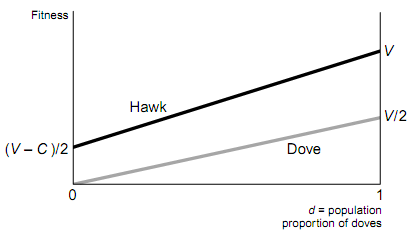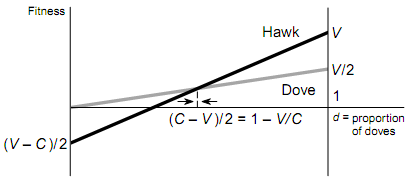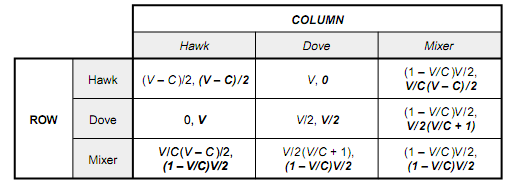How much time you want to spend on this material willdepend on the focus of your course. For many social sciencecourses, a general exposure to the ideas, based on a quick runthrough the special examples of the prisoners' dilemma andchicken games will suffice. If your class is comfortable witha bit of math, you can do the two together using the algebraicformulation of the hawk-dove game.
We have found this last method to be a satisfying way to approach the topic of evolutionary games when you have timeto devote only a single lecture to the topic. (If you want to usethis type of presentation but avoid the algebra, you can substi-tute numbers for V and C in the following analysis.) You canset up the framework of the analysis first, comparing it torational game-theoretic ideas. (Players here are phenotypeswith hardwired strategies; fitness represents payoff to theplayers; equilibrium can occur as a monomorphism-pureESS-or polymorphism-mixed ESS.) After you present thegeneral hawk-dove payoffs, it is a straightforward task to showthat when V > C, there is a prisoners' dilemma structure to thepayoffs and that when V > C, there is a chicken structure.
For the prisoners' dilemma case, the fitness graphs lookas follows:

The evolutionary stable proportion of doves in the popula-tion is 0 when the game resembles a prisoners' dilemma. Hawkis the unique ESS.
You may also want to draw a link between the repeatedprisoners' dilemma game analyzed in this chapter and Axel-rod's prisoners' dilemma tournaments. One point that could be made is that, since we now knowthat evolutionary success sometimes depends on starting conditions, Tit-for-tat may have failed to win Axelrod's tour-naments if the starting population of strategies had been sufficiently different.
For the chicken case, rational game-theoretic analysisfound two pure-strategy equilibria as well as a mixed-strategyequilibrium. For the hawk-dove game in the text, this typeof analysis finds the equilibrium mixture to put probabilityV/C on Hawk and probability 1 - V/C = (C - V)/2 on Dove.To make use of evolutionary analysis in this game, however,we need to look at the fitness graphs again:

This time, (V - C)/2 < 0, so the fitness lines cross each other.For low values of d, Dove fitness is higher than Hawk fit-ness while for high values of d, Hawk fitness is higher thanDove fitness; the value of d at the intersection is 1 - V/C.
But what is the ESS in this case? Clearly a predomi-nantly hawk population could be invaded by a mutant dove(since dove fitness is higher for small d) but a predominantlydove population can also be invaded by a mutant hawk(since hawk fitness is higher for large d). Thus neither d = 0(all Hawk) nor d = 1 (all Dove) represents a stable equilib-rium; neither Hawk nor Dove is an ESS. (Another way tothink about this is that neither of the pure strategies is evolu-tionary stable.) The other two possibilities are (1) a stablepolymorphic population (the population is mixed) and (2) apopulation in which each individual is hardwired to play amixed strategy.
To test for a stable polymorphism, we look at the dynamicsof the population proportion of doves in the fitness graphabove. The analysis just above showed that, from either ex-treme, d converges to some central value; that value is at theintersection of the two fitness graphs, d = 1 - V/C. Thegraph indicates that when the population proportion of dovesis 1 - V/C-and the population proportion of hawks is V/C,there is a stable polymorphic ESS.
The final possibility is that there might be mixers-phenotypes hardwired to play hawk some proportion of thetime and dove the rest of the time-in the population and thatmixing could be an ESS. If you have already calculated theequilibrium mixed strategy from the rational analysis of thisgame, that is the mixture to suggest as a possible ESS for themixing phenotype. If you haven't calculated it yet, you willwant to do so now and then suggest it as the appropriate wayto hardwire the mixing phenotype. The challenge then is toshow that mixing could be an ESS when V < C. You willwant to use the payoff table shown here that includes thethird possibility for each phenotype:

To see if Mixer is an ESS, you need to see if any mutantdoves or any mutant hawks could invade a predominantlymixer population. Here, you can appeal either to fitness graphs(as above) or to the algebra alone, since you will have shownseveral fitness graphs already. If there is a small proportiond of mutant doves in a predominantly mixer population,then
dove fitness is
dV/2 + (1 - d)V/2(1 - V/C) and
mixer fitness is
dV/2(V/C + 1) + (1 - d)V/2(1 - V/C).
Note that the last parts of the two expressions are identic also doves can invade only if V/2 > V/2(V/C + 1). But V/C +1 > 1, so this cannot hold and doves cannot invade. Simi-larly, hawks cannot invade. Mixer is an ESS in this version of the game.
If you have time, you could consider a game in whichphenotypes are more fit when more abundant; such a game would have a payoff structure similar to the assurance game.Then you will get two stable monomorphic equilibria at the extremes. There will also be a polymorphic equilibrium in such a game, but it will be unstable.
If you want to spend even more time on this material, you can make it come to life using some simulations of patterns that evolve according to specified rules of birth and death. Among the best known of such simulations is John Conway's game of life; Also, the Santa Fe Institute is active in research on evolving cellular automata that can mimic the patterns of life cycles of some actual organisms.
For those who cover the population dynamics in the battle of the two cultures, you may find it easier to explain to a non mathematical class if you first present it broken into two pieces. (This is best achieved with a series of over-heads.) First draw the graph with a horizontal line at y = 2/3 and show x's decreasing above the line and increasing belowit. Then draw a separate graph with a vertical line at x = 2/3and show y's increasing to the left of it and decreasing to theright. These two diagrams can then be combined (stacked ifyou are using overheads) to get the one shown in the text. For the rare class that is sufficiently mathematically trainedto cope with simple differential equations, the dynamics of Figures can also be made more precise.
Thus for the battle-of-the-two-cultures game, supposed
x/dt = 2/3 - y and dy/dt = 2/3 - x
Then
d[ (2/3 - x)2 - (2/3 - x)2 ]/dt
= -2 (2/3 - x) dx/dt + 2(2/3 - y) dy/dt = 0
Therefore the time paths are hyperbolas along which
(2/3 - x)2 - (2/3 - x)2 = constant
Similarly, in the rock-paper-scissors game, if you assume that
dq1/dt = 1 - q1 - 2q2 and dq2/dt = 2q1 + q2 - 1
then it is easy to verify that
(q1 - 1/3)2 + (q2 - 1/3)2 + (q1 - 1/3)(q2 - 1/3) = constant
and the time paths are ellipses. With a constant of proportionality k ≠ 1 in one of the differential equations, you can get stable or unstable spirals.